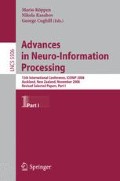Abstract
In this paper, we construct a spiking network model based on the firing-rate coding hippocampal model proposed by Becker. Basal training patterns are presented to the model network and spiking self organizing map learning is applied to the network in order to store the training patterns. We then apply a morphogenesis model in the dentate gyrus region to generate new neurons and investigate the influence of such neurogenesis on the storage and recall of novel memory. As a result, the storage capacity is essentially unchanged by the morphogenetic algorithm even when the number of training patterns is changed.
Access this chapter
Tax calculation will be finalised at checkout
Purchases are for personal use only
Preview
Unable to display preview. Download preview PDF.
References
Yonelinas, A., Kroll, N., Quamme, J., Lazzara, M., Sauve, M., Widaman, K., Knight, R.: Effects of extensive temporal lobe damage or mild hypoxia on recollection and familiarity. Nature Neuroscience 5(11), 1236–1241 (2002)
Becker, S.: A Computational Principle for Hippocampal Learning and Neurogenesis. Hippocampus 15, 722–738 (2005)
Butza, M., Lehmannb, K., Dammaschc, I.E., Teuchert-Noodta, G.: A theoretical network model to analyse neurogenesis and synaptogenesis in the dentate gyrus. Neural Networks 19, 1490–1505 (2006)
Izhikevich, E.M.: Simple Model of Spiking Neurons. IEEE Transactions on Neural Networks 14(6), 1569–1572 (2003)
Ruf, B., Schmitt, M.: Self-Organization of Spiking Neurons Using Action Potential Timing. IEEE Transactions on Neural Networks 9(3), 575–578 (1998)
Dammasch, E., Wagner, G.P., Wolff, J.R.: Self-Stabilization of Neuronal Networks. Biological Cybernetics 54, 211–222 (1986)
Author information
Authors and Affiliations
Editor information
Editors and Affiliations
Rights and permissions
Copyright information
© 2009 Springer-Verlag Berlin Heidelberg
About this paper
Cite this paper
Tabata, Y., Adachi, M. (2009). A Spiking Network of Hippocampal Model Including Neurogenesis. In: Köppen, M., Kasabov, N., Coghill, G. (eds) Advances in Neuro-Information Processing. ICONIP 2008. Lecture Notes in Computer Science, vol 5506. Springer, Berlin, Heidelberg. https://doi.org/10.1007/978-3-642-02490-0_2
Download citation
DOI: https://doi.org/10.1007/978-3-642-02490-0_2
Publisher Name: Springer, Berlin, Heidelberg
Print ISBN: 978-3-642-02489-4
Online ISBN: 978-3-642-02490-0
eBook Packages: Computer ScienceComputer Science (R0)

